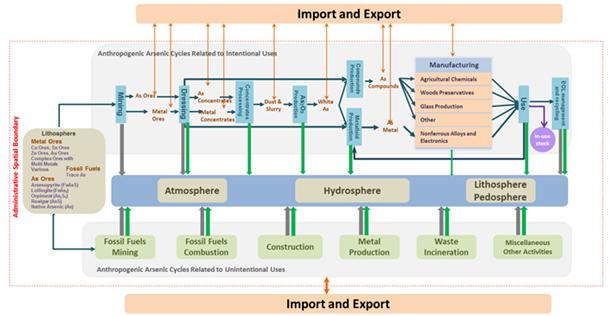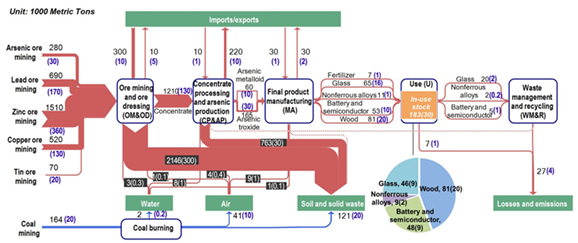Arsenic is a kind of metalloid element with toxicity. Currently, arsenic turnover caused by human activities has exceeded 50% of anthropogenic arsenic cycles, resulting in aggravation of relevant environmental and healthy problem. China is not only the biggest arsenic producer and consumer, but also one of countries that is most seriously polluted by arsenic. Even so, there still lack quite systematic investigation for arsenic caused by human activities in global environment cycle for the present day.
Group of Sustainability Science (CHEN Weiqiang’s Team ) and Group of Urban Soil and Urban Biogeochemistry (ZHU Yongguan’s Team) in Institute of Urban Environment take anthropogenic arsenic cycles(AACs) and its driving force as research objects and applies the AACs framework to provide a historical analysis of arsenic stocks and flows in China’s anthroposphere from 1990 to 2010. This framework divides AACs into intentional and unintentional uses. Intentional uses refer to those applications of the element itself that provide services or functions for modern human society, such as the use of arsenic for producing wood preservatives, etc. Unintentional uses refer to those applications of other elements or resources in which the concerned element is just an unavoidable (and in many cases unwanted) impurity, such as the mining and emission of arsenic contained in coals during the mining and combustion of coals.
The investigation indicates that arsenic mostly enters modern anthroposphere as a companion element of nonferrous metal ores and almost all intentional uses of arsenic not only are unrecyclable but also result in emissions that may last years or decades after being used. Over the past twenty years, the scale of arsenic cycles in China has been increasing constantly, resulting that China has became the biggest producer and user of arsenic all over the world. Arsenic entered China’s anthroposphere reaches 300,000 ± 57,000 t in 2010. More than 90 % (by weight in 2010) of all these arsenic inputs got back to the environment by depositing in the tailing or releasing to the atmosphere and aquatic system. Only less than 6% (by weight in 2010) of total arsenic input to China’s anthroposphere was used for intentional uses including glass making, wood preservatives, batteries, semiconductors, and alloys, etc. The remaining 3% (by weight in 2010) was exported as arsenic bearing products to other anthropogenic systems. Especially, China has been the biggest net exporter of arsenic trioxide and arsenic metalloid globally, thus suffering from the environmental burdens of producing arsenic products for other economies. It’s noteworthy that the growth of arsenic use in China is driven by simultaneous increases in many intentional applications including pesticide, fertilizer, glass making, wood preservatives, batteries, semiconductors, and arsenic alloy, etc. The dissipative arsenic emissions resulting from intentional applications are at the same order of magnitude as atmospheric emissions from coal combustion, and these arsenic emissions are almost ignored in the existing list of emission accounting. Therefore, the investigation promotes a significant step in generating a more comprehensive lists of arsenic emissions and relevant risk early warning for environment and health.
The investigation is supported by the CAS Pioneer High-level Talents Program and the revelant achievements are published as below:
①CHEN, W.-Q.*; SHI, Y.-L.; WU, S.-L.; and ZHU, Y.-G.* Anthropogenic Arsenic Cycles: A Research Framework and Features. Journal of Cleaner Production. 2016, 139:328-336.
②SHI, Y.-L.; CHEN, W.-Q.*; WU, S.-L.; and ZHU, Y.-G. Anthropogenic Cycles of Arsenic in Mainland China: 1990-2010. Environmental Science & Technology. 2017, in press. DOI: 10.1021/acs.est.6b01669

Figure 1. A research framework for characterizing anthropogenic arsenic cycles related to intentional uses and resulting from unintentional uses in national or global anthropogenic systems.
Figure Source: CHEN, W.-Q.*; SHI, Y.-L.; WU, S.-L.; and ZHU, Y.-G.* Anthropogenic Arsenic Cycles: A Research Framework and Features. Journal of Cleaner Production. 2016, 139:328-336.

Figure 2. Anthropogenic arsenic cycles related to intentional uses in China for 1990-2010.
Figure Source: SHI, Y.-L.; CHEN, W.-Q.*; WU, S.-L.; and ZHU, Y.-G. Anthropogenic Cycles of Arsenic in Mainland China: 1990-2010. Environmental Science & Technology. 2017, in press. DOI: 10.1021/acs.est.6b01669